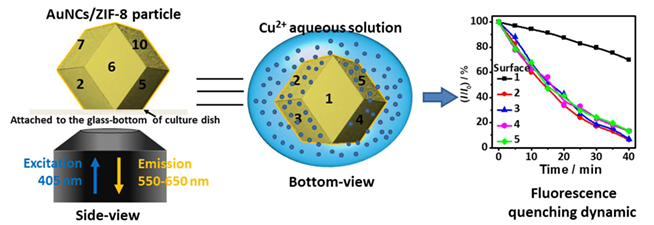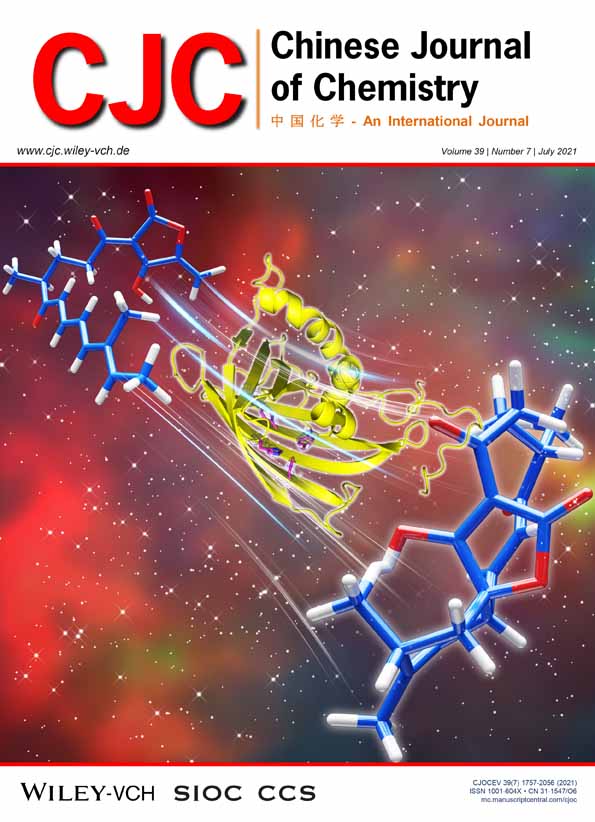Single Particle-Based Confocal Laser Scanning Microscopy for Visual Detection of Copper Ions in Confined Space†
Ke Wang
Key Laboratory of Analytical Chemistry for Life Science of Shaanxi Province, School of Chemistry and Chemical Engineering, Shaanxi Normal University, Xi'an, Shaanxi, 710062 China
Search for more papers by this authorManping Qian
Key Laboratory of Analytical Chemistry for Life Science of Shaanxi Province, School of Chemistry and Chemical Engineering, Shaanxi Normal University, Xi'an, Shaanxi, 710062 China
Search for more papers by this authorCorresponding Author
Honglan Qi
Key Laboratory of Analytical Chemistry for Life Science of Shaanxi Province, School of Chemistry and Chemical Engineering, Shaanxi Normal University, Xi'an, Shaanxi, 710062 China
E-mail: [email protected]Search for more papers by this authorQiang Gao
Key Laboratory of Analytical Chemistry for Life Science of Shaanxi Province, School of Chemistry and Chemical Engineering, Shaanxi Normal University, Xi'an, Shaanxi, 710062 China
Search for more papers by this authorChengxiao Zhang
Key Laboratory of Analytical Chemistry for Life Science of Shaanxi Province, School of Chemistry and Chemical Engineering, Shaanxi Normal University, Xi'an, Shaanxi, 710062 China
Search for more papers by this authorKe Wang
Key Laboratory of Analytical Chemistry for Life Science of Shaanxi Province, School of Chemistry and Chemical Engineering, Shaanxi Normal University, Xi'an, Shaanxi, 710062 China
Search for more papers by this authorManping Qian
Key Laboratory of Analytical Chemistry for Life Science of Shaanxi Province, School of Chemistry and Chemical Engineering, Shaanxi Normal University, Xi'an, Shaanxi, 710062 China
Search for more papers by this authorCorresponding Author
Honglan Qi
Key Laboratory of Analytical Chemistry for Life Science of Shaanxi Province, School of Chemistry and Chemical Engineering, Shaanxi Normal University, Xi'an, Shaanxi, 710062 China
E-mail: [email protected]Search for more papers by this authorQiang Gao
Key Laboratory of Analytical Chemistry for Life Science of Shaanxi Province, School of Chemistry and Chemical Engineering, Shaanxi Normal University, Xi'an, Shaanxi, 710062 China
Search for more papers by this authorChengxiao Zhang
Key Laboratory of Analytical Chemistry for Life Science of Shaanxi Province, School of Chemistry and Chemical Engineering, Shaanxi Normal University, Xi'an, Shaanxi, 710062 China
Search for more papers by this author†Dedicate to the Special Issue of In Situ Target Biomolecule Analysis in Confined Nanospace.
Main observation and conclusion
A single particle-based confocal laser scanning microscopy was developed for the visual detection of copper ions in confined space. A fluorescence microparticle, named AuNCs/ZIF-8, was synthesized by coating gold nanoclusters (AuNCs) onto the outer surface of zeolitic imidazolate framework-8 (ZIF-8). The morphology and solid-state fluorescence property of AuNCs/ZIF-8 were characterized by scanning electron microscopy and fluorescence technique. The AuNCs/ZIF-8 exhibits turn-off responses to copper ions via fluorescence quenching in the range of 2—15 μmol·L–1 with a detection limit of 0.9 μmol·L–1. More importantly, the distribution of AuNCs on single ZIF-8 crystal and the fluorescence quenching dynamics on single AuNCs/ZIF-8 were visualized by 3D-reconstructed fluorescence imaging. Different distribution of AuNCs on the different surfaces of single ZIF-8 crystal and similar fluorescence quenching dynamics on the different surfaces of single AuNCs/ZIF-8 were obtained. These results offer insights into the nature of the fluorescence active sites and the fluorescence quenching dynamics on a single fluorescence particle, which also opens up new opportunities for in situ target biomolecule analysis in confined space.
Supporting Information
| Filename | Description |
|---|---|
| cjoc202000727-sup-0001-Supinfo.pdfPDF document, 1,012 KB |
Appendix S1: Supporting Information |
Please note: The publisher is not responsible for the content or functionality of any supporting information supplied by the authors. Any queries (other than missing content) should be directed to the corresponding author for the article.
References
- 1 Ye, Z.; Wei, L.; Xiao, L.; Wang, J. Laser illumination-induced dramatic catalytic activity change on Au nanospheres. Chem. Sci. 2019, 10, 5793–5800.
- 2 Chen, T.; Dong, B.; Chen, K. Zhao, F.; Cheng, X.; Ma, C.; Lee, S.; Zhang, P.; Kang, S. H.; Ha, J. W.; Xu, W.; Fang, N. Optical super-resolution imaging of surface reactions. Chem. Rev. 2017, 117, 7510–7537.
- 3 Xu, X.; Li, T.; Xu, Z.; Wei, H.; Lin, R.; Xia, B.; Liu, F.; Li, N. Automatic enumeration of gold nanomaterials at the single-particle level. Anal. Chem. 2015, 87, 2576–2581.
- 4 Wang, W.-K.; Chen, J.-J.; Lou, Z.-Z.; Kim, S.; Fujitsuka, M.; Yu, H.-Q.; Majima, T. Single-molecule and -particle probing crystal edge/corner as highly efficient photocatalytic sites on a single TiO2 particle. Proc. Natl. Acad. Sci. U. S. A. 2019, 116, 18827–18833.
- 5 Ameloot, R.; Vermoortele, F.; Hofkens, J.; Schryver, F. C. D.; Vos, D. E. D.; Roeffaers, M. B. J. Three-dimensional visualization of defects formed during the synthesis of metal–organic frameworks: a fluorescence microscopy study. Angew. Chem. Int. Ed. 2013, 52, 401–405.
- 6 Kubarev, A. V.; Roeffaers, M. B. J. Surface acid–base catalytic activity of ZIF-8 revealed by super-resolution fluorescence microscopy. CrystEngComm 2017, 19, 4162–4165.
- 7 Feng, Q.; Qi, Y.; Chen, D.; Liu, C. One bead three targets: An enzyme- free platform enabling simultaneous detection of multiplex MicroRNAs on a single microbead. Sen. Actuators B: Chem. 2019, 301, 127119.
- 8 Wu, S.-P.; Huang, R.-Y.; Du, K.-J. Colorimetric sensing of Cu(II) by 2-methyl-3-[(pyridin-2-ylmethyl)-amino]-1,4-naphthoquinone: Cu(II) induced deprotonation of NH responsible for color changes. Dalton Trans. 2009, 4735–4740.
- 9 Zhang, S.; Yu, T.; Sun, M.; Yu, H.; Zhang, Z.; Wang, S.; Jiang, H. Highly sensitive and selective fluorescence detection of copper (II) ion based on multi-ligand metal chelation. Talanta 2014, 126, 185–190.
- 10 Shen, Q.; Li, W.; Tang, S.; Hu, Y.; Nie, Z.; Huang, Y.; Yao, S. A simple “clickable” biosensor for colorimetric detection of copper (II) ions based on unmodified gold nanoparticles. Biosens. Bioelectron. 2013, 41, 663–668.
- 11 Park, Y.; Lee, C.; Park, K.; Park, H. Enzyme-free colorimetric detection of Cu2+ by utilizing target-triggered DNAzymes and toehold-mediated DNA strand displacement events. Chem. - Eur. J. 2017, 23, 17379–17383.
- 12 Zhou, M.; Han, L.; Deng, D.; Zhang, Z.; He, H.; Zhang, L.; Luo, L. 4-Mercaptobenzoic acid modified silver nanoparticles-enhanced electrochemical sensor for highly sensitive detection of Cu2+. Sen. Actuators B: Chem. 2019, 291, 164–169.
- 13 Cheng, C.; Huang, Y.; Tian, X.; Zheng, B.; Li, Y.; Yuan, H.; Xiao, D.; Xie, S.; Choi, M. M. F. Electrogenerated chemiluminescence behavior of graphite-like carbon nitride and its application in selective sensing Cu2+. Anal. Chem. 2012, 84, 4754–4759.
- 14 Liu, Y.; Wu, Y.; Guo, X.; Wen, Y.; Yang, H. Rapid and selective detection of trace Cu2+ by accumulation-reaction-based Raman spectroscopy. Sen. Actuators B: Chem. 2019, 283, 278–283.
- 15 Pu, L. Fluorescence of organic molecules in chiral recognition. Chem. Rev. 2004, 104, 1687–1716.
- 16 Chan, W. C. W.; Maxwell, D. J.; Gao, X.; Bailey, R. E.; Han, M.; Nie, S. Luminescent quantum dots for multiplexed biological detection and imaging. Curr. Opin. Biotechnol. 2002, 13, 40–46.
- 17 McQuade, D. T.; Pullen, A. E.; Swager, T. M. Conjugated polymer- based chemical sensors. Chem. Rev. 2000, 100, 2537–2574.
- 18 Liu, S.; Cheng, J.; Xu, J. New dopa-AIE compound used as fluorescence sensor material: specificity and quantification for Cu(II). Chin. J. Chem. 2017, 35, 335–340.
- 19 Shang, L.; Dong, S.; Nienhaus, G. U. Ultra-small fluorescent metal nanoclusters: synthesis and biological applications. Nano Today 2011, 6, 401–418.
- 20 Xie, Y.; Xianyu, Y.; Wang, N.; Yan, Z.; Liu, Y.; Zhu, K.; Hatzakis, N. S.; Jiang, X. Functionalized gold nanoclusters identify highly reactive oxygen species in living organisms. Adv. Funct. Mater. 2018, 28, 1702026.
- 21 Luo, Z.; Yuan, X.; Yu, Y.; Zhang, Q.; Leong, D. T.; Lee, J. Y.; Xie, J. From aggregation-induced emission of Au(I)−thiolate complexes to ultrabright Au(0)@Au(I)−thiolate core−shell nanoclusters. J. Am. Chem. Soc. 2012, 134, 16662–16670.
- 22 Wang, K.; Qian, M.; Qi, H.; Gao, Q.; Zhang, C. Multifunctional zeolitic imidazolate framework-8 for real-time monitoring ATP fluctuation in mitochondria during photodynamic therapy. Nanoscale 2020, 12, 15663–15669.
- 23 Yang, L.; Lu, H. Microwave-assisted ionothermal synthesis and characterization of zeolitic imidazolate framework-8. Chin. J. Chem. 2012, 30, 1040–1044.
- 24 Troyano, J.; Carné-Sánchez, A.; Avci, C.; Imaz, I.; Maspoch, D. Colloidal metal–organic framework particles: the pioneering case of ZIF-8. Chem. Soc. Rev. 2019, 48, 5534–5546.
- 25 Park, K. S.; Ni, Z.; Cóté, A. P.; Choi, J. Y.; Huang, R.; Uribe-Romo, F. J.; Chae, H. K.; O'Keeffe, M.; Yaghi, O. M. Exceptional chemical and thermal stability of zeolitic imidazolate frameworks. Proc. Natl. Acad. Sci. U. S. A. 2006, 103, 10186–10191.
- 26 Pang, S. H.; Han, C.; Sholl, D. S.; Jones, C. W.; Lively, R. P. Facet-specific stability of ZIF 8 in the presence of acid gases dissolved in aqueous solutions. Chem. Mater. 2016, 28, 6960–6967.
- 27 Wang, L.; Cao, H.-X.; He, Y.-S.; Pan, C.-G.; Sun, T.-K.; Zhang, X.-Y.; Wang, C.-Y.; Liang, G.-X. Facile preparation of amino-carbon dots/gold nanoclusters FRET ratiometric fluorescent probe for sensing of Pb2+/Cu2+. Sen. Actuators B: Chem. 2019, 282, 78–84.
- 28 Deng, H. H.; Zhang, L. N.; He, S.B.; Liu, A. L.; Li, G. W.; Lin, X. H.; Xia, X. H.; Chen, W. Methionine-directed fabrication of gold nanoclusters with yellow fluorescent emission for Cu2+ sensing. Biosens. Bioelectron. 2015, 65, 397–403.
- 29 Tan, Q.; Zhang, R.; Zhang, G.; Liu, X.; Qu, F.; Lu, L. Embedding carbon dots and gold nanoclusters in metal-organic frameworks for ratiometric fluorescence detection of Cu2+. Anal. Bioanal. Chem. 2020, 412, 1317–1324.
- 30 Deng, H.; Fang, X.-Y.; Huang, K.-Y.; He, S.-B.; Peng, H.-P.; Xia, X.-H.; Chen, W. Regulation of metal ion selectivity of fluorescent gold nanoclusters by metallophilic interactions. Anal. Chim. Acta 2019, 1088, 116–122.
- 31 Chen, J.-K.; Yang, S.-M.; Li, B.-H.; Lin, C.-H.; Lee, S. Fluorescence quenching investigation of methyl red adsorption on aluminum- based metal−organic frameworks. Langmuir 2018, 34, 1441–1446.
- 32 Cramb, D. T.; Beck, S. C. Fluorescence quenching mechanisms in micelles: the effect of high quencher concentration. J. Photochem. Photobiol. A 2000, 134, 87–95.




